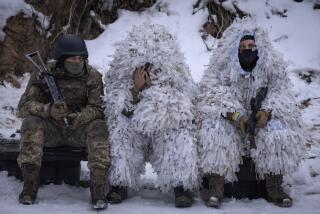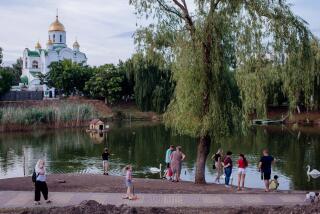Once Known Primarily as Land of Icy Exile : Siberia--Symbol of Economic Rebirth
- Share via
IRKUTSK, Soviet Union — Siberia, once known primarily as a place of icy exile, is becoming a symbol of economic renaissance for the Soviet Union.
Timber and fur-bearing animals exemplify the riches to be found above the deep snow cover in this vast region that stretches from the Ural Mountains to the Pacific Ocean. However, the mineral resources below the surface--among them oil, coal and natural gas--are what promise to bring radical change to Siberia in the coming decades.
“Siberia is the foundation of the Soviet economy of the 21st Century,” Abel Aganbegyan, a leading economist and champion of Siberian development, said in a recent interview with Tass, the Soviet government news agency.
Siberia has already made the Soviet Union the world’s leading producer of oil and natural gas, although oil was first found there only 20 years ago. This year, the target is about 2.7 billion barrels of oil and scores of billions of cubic feet of natural gas.
One of Last Frontiers
In some respects, Siberia is one of the world’s last frontiers, a land where incredible distances and extreme cold pose a challenge to the most determined developer.
In many areas, there are no roads; cargo is trucked over frozen rivers and lakes. Color television sets may arrive at remote villages on horse-drawn sleds. Many Siberians still live in picturesque wooden houses that have intricate carving over the windows but no running water.
The minerals are found mainly in inhospitable northern Siberia, where the temperature regularly falls to 40 degrees below zero Fahrenheit and snow covers the ground from September through April. Winter, they say here, “lasts for 12 months, and the rest of the year is summer.”
F.M. Borodkin, an economist at the Academic City Research Center in Novosibirsk, says that “where there are mineral resources, there are few people, and where there are people, there are few resources.”
Many Siberians believe that they have developed special traits that help them overcome the climate and the isolation in a harsh land.
Like American Pioneers
Galina F. Lapteva, a doctor in Novosibirsk, said in an interview: “Siberians have a different psychological makeup. They are less demanding of the state and more cordial to each other. Siberians resemble American pioneers in a way, since they both came to a strange and hostile environment and therefore had to cling to each other.”
Siberia was discovered and claimed for Russia by Cossack warriors more than 300 years ago. For centuries, under the czars and their Communist successors, it was used as a place of exile or imprisonment. It still is, but today the state also offers double and triple pay to attract workers to Siberia. Even so, there is a labor shortage and high turnover because of the cold and lack of comforts.
Siberia accounts for 60% of the Soviet Union’s land mass but only 8% of its people. Even so, according to Borodkin, the sparse population does not place severe constraints on economic growth.
Aganbegyan and others insist that the Soviet Union has no choice but to “go east,” since energy and mineral resources are rapidly dwindling in the European part of the country, where most of the Soviet people live.
Move East ‘Unprecedented’
“This eastward move . . . is unprecedented in the history of world development in scale and scope,” Aganbegyan has said.
Irkutsk, once a sleepy village of fur trappers, reflects the change. It is now a city of 500,000 and serves as a base camp, in effect, for the expansion of mining and drilling activities to the north.
Change has not come without controversy. When city officials announced their intention of tearing down the old wooden houses and shifting their occupants to new, concrete-slab apartment buildings, not everyone was happy about it.
Valentin G. Rasputin, a well-known novelist and leader of the Village Writers group, fired off protests against the destruction of the wooden houses. Other townspeople contend that Rasputin is being overly nostalgic.
Irkutsk is the capital of a territory larger than France but with fewer than 3 million people. Its population is growing by 30,000 a year, though, and this is putting pressure on schools and housing.
Average Age 26
Not far to the north, the new city of Ust-Ilimsk has 100,000 people. Their average age is 26. Many were brought to Ust-Ilimsk to work on the huge dam at Bratsk and stayed on to take jobs in factories using power generated at the dam.
Elsewhere, 20th-Century technology contrasts with time-honored ways. On the Taymyr Peninsula, the northernmost point on the Eurasian land mass, helicopters regularly deliver supplies to herdsmen tending reindeer.
In the snowy forests of pine and silver birch, fur-clad hunters with dogs--a Siberian breed called laika , similar to the husky--track squirrels as they did generations ago. Meanwhile, wooden cottages sprout television antennas in the background.
People in this cold country still use the “Siberian refrigerator,” a string bag hung outside a window. It usually contains perishable edibles, including pelmeni , a meat dumpling.
These dumplings are customarily made with three different kinds of meat, including moose or polar bear when available, rolled into a special dough. They are placed in a string bag in the subfreezing air for a few months--”to make them taste better,” as one cook put it.
Laboratories and Abacuses
At Academic City in Novosibirsk, nuclear physicists who work in ultramodern laboratories lunch in a restaurant where their bills are calculated on an abacus.
Academic City, the pride of Siberia, was built as a new town in 1957 at a cost of 300 million rubles (about $340 million). It was designed to bring in some of the best brains from universities in Moscow and Leningrad to help in the region’s development.
Today, it is a city of 40,000 people and 23 research institutes in a wooded setting on the shores of a man-made lake. The scholars working there include 70 members of the Soviet Academy of Sciences. About 400 of the scholars have doctoral degrees, and 3,500 are candidates for doctorates.
There is no industry in Academic City, which was designed for pleasant living. Research buildings are within easy walking distance of residential areas, and the line between work and private life is blurred, as in many other academic communities.
“Work and private life are so intertwined,” one scholar said. “This is the main drawback. Habit and tradition are so strong that you can’t pass your institute without going in to work on some project.”
Inventions Pay for Buildings
In part because of this atmosphere, Soviet officials say, Academic City produced in its first seven years enough inventions and new ideas to pay off its construction costs.
Not everything in Siberia is so efficient. Recently, there have been press reports of widespread heating-system failures in western Siberia, with temperatures in some apartments dropping below freezing.
Even worse, Izvestia, the official government newspaper, has reported a severe shortage of valenki , the traditional Siberian felt boots. Despite growing demand, Izvestia said, factories making the weather-proof boots have reduced production, and a system of priorities has been put into effect.
Siberians, though, are proud of their ability to overcome the frigid climate. A taxi driver in Ulan Ude scoffed at a visitor’s concern about subfreezing temperatures and pulled up his sweater to show that he was wearing no undershirt.
“We feel better when it’s cold,” he said.
More to Read
Sign up for Essential California
The most important California stories and recommendations in your inbox every morning.
You may occasionally receive promotional content from the Los Angeles Times.













